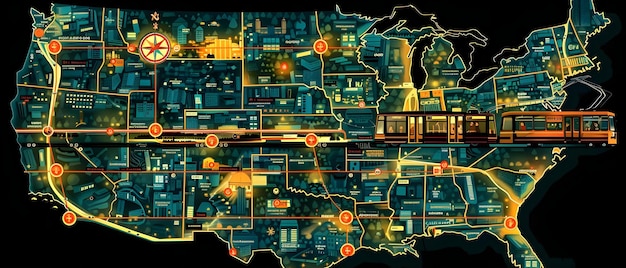The Future of Autonomous Trucking: US Regulatory Challenges

The Future of Autonomous Trucking: Navigating Regulatory Hurdles in the US involves addressing safety standards, operational guidelines, and liability frameworks to ensure the safe and efficient integration of self-driving trucks on American roads.
The rise of autonomous trucking promises to revolutionize the transportation industry, but its deployment in the US hinges on effectively navigating complex regulatory hurdles. Understanding these challenges is crucial for stakeholders seeking to shape the Future of Autonomous Trucking: Navigating Regulatory Hurdles in the US.
Understanding the Landscape of Autonomous Trucking
Autonomous trucking is rapidly evolving, attracting significant investment and innovation. Understanding the current landscape involves assessing the technological advancements, market potential, and potential societal impacts of self-driving trucks.
Technological Advancements in Autonomous Trucks
The technology behind autonomous trucks includes advanced sensors, artificial intelligence, and sophisticated control systems. These systems enable trucks to perceive their environment, make decisions, and navigate roads without human intervention.
Market Potential and Economic Impacts
Autonomous trucking offers the potential for increased efficiency, reduced costs, and improved safety in the transportation industry. It also raises questions about workforce displacement and the need for retraining programs.

The economic benefits of autonomous trucking are substantial, but so are the challenges. The industry must address concerns about job losses and ensure a smooth transition for truck drivers.
- Enhanced Fuel Efficiency: Autonomous trucks can optimize speed and routing to minimize fuel consumption.
- Reduced Labor Costs: Self-driving trucks can operate around the clock, reducing the need for multiple drivers.
- Improved Safety: Autonomous systems can eliminate human error, a leading cause of truck accidents.
- Increased Capacity: Autonomous trucks can potentially operate closer together, increasing highway capacity.
The autonomous trucking landscape is dynamic, with ongoing technological developments and market shifts. Understanding these factors is essential for navigating the regulatory environment and realizing the full potential of self-driving trucks.
The Current Regulatory Framework in the US
The regulatory framework for autonomous vehicles in the US is fragmented, with varying approaches at the federal and state levels. This patchwork of regulations creates uncertainty for companies seeking to deploy autonomous trucks across state lines.
Federal Oversight and Guidelines
At the federal level, the National Highway Traffic Safety Administration (NHTSA) plays a key role in setting safety standards for motor vehicles. NHTSA has issued voluntary guidelines for autonomous vehicles, but there is no comprehensive federal law regulating self-driving trucks.
State Regulations and Pilot Programs
Many states have enacted laws or executive orders related to autonomous vehicles, but these regulations vary widely. Some states have embraced autonomous trucking, while others have adopted a more cautious approach.

The lack of uniformity in state regulations presents a significant challenge for autonomous trucking companies. Companies must navigate a complex web of rules and adapt their operations to comply with different state laws.
- California: Permits autonomous truck testing but requires a human driver behind the wheel.
- Texas: Has generally supportive regulations and is a popular location for autonomous truck development.
- Arizona: Has relatively few regulations and has attracted significant autonomous vehicle testing.
- Florida: Allows autonomous vehicles to operate without a human driver, subject to certain conditions.
The current regulatory framework in the US is evolving, with ongoing debates about the appropriate level of oversight and the need for national standards. Understanding this framework is crucial for companies seeking to deploy autonomous trucks in the US.
Key Regulatory Hurdles for Autonomous Trucking
Several key regulatory hurdles must be addressed to facilitate the widespread deployment of autonomous trucking in the US. These include safety standards, operational guidelines, and liability frameworks.
Safety Standards and Testing Requirements
Establishing robust safety standards and testing requirements is essential for ensuring the safe operation of autonomous trucks. These standards must address a range of issues, including vehicle performance, cybersecurity, and data privacy.
Rigorous testing is necessary to validate the safety and reliability of autonomous trucking systems. This testing should include both simulations and real-world driving scenarios.
Operational Guidelines and Licensing
Operational guidelines are needed to govern how autonomous trucks can be used on public roads. These guidelines should address issues such as speed limits, hours of service, and route restrictions.
Licensing requirements for autonomous truck operators are also needed to ensure that individuals responsible for overseeing autonomous trucking operations have the necessary training and qualifications.
- Defining Operational Design Domains (ODDs): Clearly specifying the conditions under which autonomous trucks can operate safely.
- Ensuring Cybersecurity: Protecting autonomous systems from hacking and other cyber threats.
- Addressing Data Privacy: Safeguarding data collected by autonomous trucks and protecting individual privacy.
- Establishing Remote Monitoring Protocols: Defining the role of remote human operators in overseeing autonomous truck operations.
Addressing these regulatory hurdles is crucial for fostering public trust in autonomous trucking and ensuring the safe and efficient integration of self-driving trucks into the transportation system.
Liability and Insurance Considerations
Determining liability in the event of an accident involving an autonomous truck is a complex legal issue. Traditional insurance models may not be adequate for covering the unique risks associated with self-driving vehicles.
Determining Liability in Accidents
In traditional car accidents, liability is typically assigned to the driver at fault. However, in the case of autonomous trucks, liability could potentially fall on the vehicle manufacturer, the software developer, or the owner of the truck.
Establishing clear legal frameworks for assigning liability is essential for protecting consumers and ensuring that responsible parties are held accountable in the event of an accident.
Insurance Coverage for Autonomous Trucks
Insurance companies are developing new insurance products to address the risks associated with autonomous vehicles. These products may cover a range of liabilities, including property damage, bodily injury, and cyberattacks.
- Updating Insurance Regulations: Adapting insurance regulations to address the unique risks of autonomous vehicles.
- Developing New Insurance Products: Creating insurance products that cover the liabilities associated with self-driving trucks.
- Establishing Data Sharing Protocols: Sharing data between autonomous vehicle manufacturers, insurance companies, and regulators to improve safety and reduce risks.
- Addressing Cybersecurity Risks: Providing insurance coverage for cyberattacks that could compromise the safety of autonomous trucks.
Addressing liability and insurance considerations is critical for creating a stable and predictable legal environment for autonomous trucking. This will encourage innovation and investment in the industry while protecting the rights of consumers.
The Role of Public Perception and Acceptance
Public perception plays a crucial role in the adoption of autonomous trucking. Addressing public concerns about safety, job displacement, and other potential impacts is essential for building trust in self-driving trucks.
Addressing Public Concerns About Safety
Many people are hesitant to trust autonomous vehicles, particularly large trucks, to operate safely on public roads. Addressing these concerns requires transparency about the technology, rigorous testing, and clear safety standards.
Demonstrating the safety benefits of autonomous trucking through data and real-world examples can help to build public confidence in self-driving trucks.
Communicating the Benefits of Autonomous Trucking
Highlighting the economic, environmental, and safety benefits of autonomous trucking can help to increase public support for the technology. This includes emphasizing the potential for reduced traffic congestion, lower emissions, and fewer accidents.
Effective communication strategies are needed to educate the public about the potential benefits of autonomous trucking and to address any misconceptions or fears.
- Public Education Campaigns: Launching campaigns to educate the public about the technology and its potential benefits.
- Community Engagement Programs: Engaging with local communities to address concerns and build relationships.
- Transparency and Data Sharing: Providing access to data and information about the safety and performance of autonomous trucks.
- Addressing Job Displacement Concerns: Developing retraining programs and other initiatives to help truck drivers transition to new roles.
Building public trust and acceptance is essential for the successful deployment of autonomous trucking. This requires a collaborative effort involving industry, government, and the public.
The Future of Autonomous Trucking Regulations
The future of autonomous trucking regulations in the US will likely involve a combination of federal and state oversight. Collaboration between government, industry, and other stakeholders is essential for developing effective and harmonized regulations.
The Need for Federal Standards
Many experts argue that federal standards are needed to ensure a consistent and predictable regulatory environment for autonomous trucking. This would help to avoid the patchwork of state regulations that currently exists and facilitate the interstate deployment of self-driving trucks.
The Importance of Collaboration
Developing effective regulations requires collaboration between government agencies, industry stakeholders, academic researchers, and the public. This collaboration should focus on identifying best practices, addressing potential risks, and promoting innovation.
International cooperation is also important, as autonomous trucking technology is being developed and deployed in countries around the world.
- Establishing a Federal Advisory Committee: Creating a committee of experts to advise the government on autonomous trucking regulations.
- Harmonizing State Regulations: Working to align state regulations to create a more consistent regulatory environment.
- Promoting Innovation: Fostering innovation by avoiding overly prescriptive regulations that could stifle technological development.
- Addressing Ethical Considerations: Considering the ethical implications of autonomous trucking, such as issues related to privacy, security, and job displacement.
The future of autonomous trucking regulations will shape the development and deployment of self-driving trucks in the US. By adopting a collaborative and forward-thinking approach, policymakers can help to realize the full potential of this transformative technology while protecting the public interest.
| Key Point | Brief Description |
|---|---|
| 🚦 Regulatory Framework | Fragmented federal and state regulations create uncertainty. |
| 🛡️ Safety Standards | Robust standards and testing are essential for safe operation. |
| ⚖️ Liability Concerns | Determining liability in accidents is a complex legal issue. |
| 📢 Public Perception | Addressing public concerns builds trust in self-driving trucks. |
Frequently Asked Questions
▼
Autonomous trucking offers increased efficiency, reduced costs, and improved safety by minimizing human error and optimizing fuel consumption.
▼
State regulations vary widely. Some states permit testing with a human driver, while others allow operation without one, creating inconsistent rules.
▼
Liability could fall on the vehicle manufacturer, software developer, or truck owner, necessitating clear legal frameworks and updated insurance regulations.
▼
Public concerns include safety, job displacement, and data privacy. Addressing these points through transparency and education builds trust.
▼
Federal standards can ensure consistency and predictability across states, avoiding the current patchwork of varied regulations while promoting innovation.
Conclusion
The Future of Autonomous Trucking: Navigating Regulatory Hurdles in the US requires addressing safety standards, liability frameworks, and public perception through collaborative efforts between government, industry, and the public to ensure safe and efficient integration of self-driving trucks.





